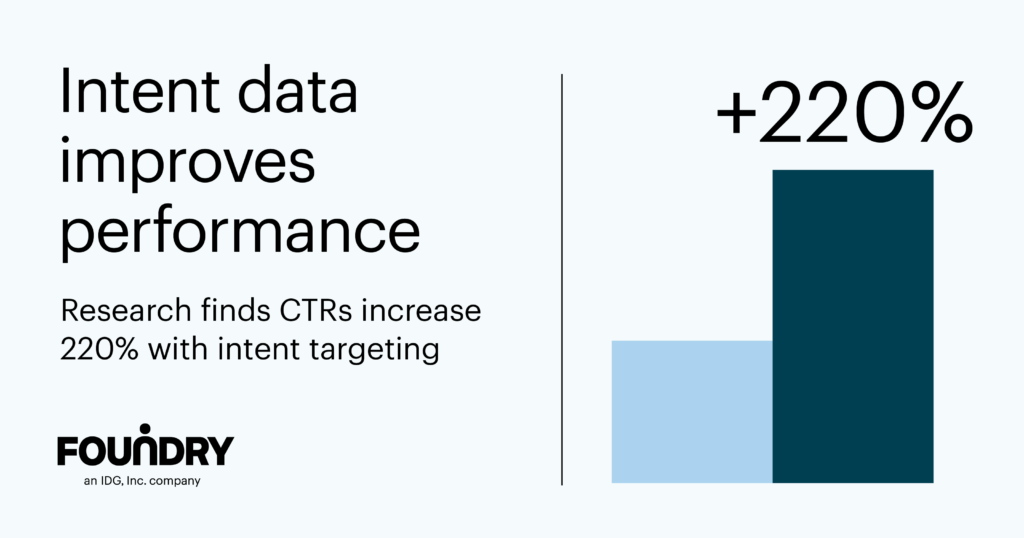
Marketing efficiency has been a hot topic throughout the last year. With new ideas, technology, and points of view informing marketers what their best bet is to do more with less, how do you anchor your strategy in what drives real results and generates revenue?
It all comes back to the basics. Market to those who want to be marketed to. Identify active buyers facing a challenge you solve, and make sure they know who you are and how you can help.
Enter: intent data. Intent is championed as a silver bullet for reaching in-market buyers. Some doubt if it really works or if generic ICP-based targeting is still the way to go. So, we set out to find the answer.
Does intent data improve ad efficiency, and by how much?
The short answer? Yes. Research shows campaigns using intent-based targeting were 2.5x more efficient than campaigns using standard targeting dimensions.
Read: Foundry’s recent peer-reviewed research in I-COM’s Frontiers of Marketing Journal testing the impact of multi-source intent for ad efficiency.
Authors: Olivia Kenney, Sreejata Chatterjee, Kundan Kumar.
The experiment
We tested intent-based ad audiences across three clients in technology and software spaces to compare standard firmographic and intent-based targeting. The goal was to replicate how ads are typically run, compared to only targeting in-market buyers, to see if intent really does make a difference in campaign performance.
Control and exposed groups were established to test our hypothesis: focusing ad targeting on audiences that have shown intent improves campaign efficiency.
Control group: a randomized group based on the clients’ ICP using standard firmographic targeting dimensions such as job title, company size, and industry.
Exposed (intent-based) group: identified using intent signals such as competitor engagements, content interactions, current job posts, and tech installs across first-, second-, and third-party intent sources, then filtered that audience by the clients’ ICP.
For the intent-based audiences, it was important to capture prospective buyers across the buying journey, so using data from the multiple sources Foundry collects helped us capture a fuller picture of who’s in-market.
The results
Compared to the control group campaigns, intent-based ads were 2.5x more efficient.
- 83.5% more impressions
- 220% higher click-through rate
- 59.6% lower cost-per-conversion
Ad platforms like Google prefer to show ads to people likely to click them, creating a self-fulfilling prophecy with intent-based audiences. Since you’re reaching audiences looking for what you’re selling, they’re more likely to engage. And since they’re more likely to engage, Google’s more likely to serve them your ads, increasing impressions and clicks at a lower cost.
Taking a leap towards intent-based targeting gives marketers the opportunity to drastically improve campaign engagement while keeping costs low.
The next steps
The research shows that intent works. But what does it take to put it into practice?
Step 1: Define what intent means for your business.
What actions could someone take that would hint they’re in-market to buy or could get value from what you’re offering? It could be visits to your website, reading solution-based content, expanding a certain team, attending relevant events, hiring new leadership, or chatting with peers on public forums.
Keep in mind most of these signals aren’t happening in a single, standardized place. Make sure you capture intent behavior across the channels they take place: your website, social media, publisher sites, job boards, press releases, and the list goes on. Gaining access to as much of the buyer’s journey as you can means you aren’t just building a bigger audience, but you’re understanding what resonates with who, where, and when it needs to.
Step 2: Run ads that enable intent-based targeting.
Select ad vendors and channels that have the ability to meaningfully reach your intent-based audience. It could be built into the platform or managed by the vendor. Meaningfully here means they aren’t simply ingesting the audience but are allowing you to tailor messaging to buying behavior as it ebbs and flows through the funnel.
The place to start
Ideally, you run ads on channels that not only use intent data as a targeting dimension, but that also serve ads to your buyers in the places they’re making decisions. Because ultimately, all most people want is to scroll the internet, only seeing what’s interesting and relevant to them in their feeds.
Foundry Ads opens the door to your audience across the sites they’ve used to make decisions for decades, with intent data built-in. It enables marketers like you to engage buyers with ad placements and messaging that take real-time intent into account. So, you meet your buyers where they’re at, with efficiency that makes your team, stakeholders, and, most importantly, audience happy.




